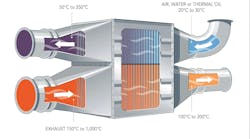Process industries share challenges similar to those faced by hybrid and discrete production. All three industrial segments look to automation and plant IT for support. Yet process plants often operate continuously, for years even, making it more difficult to beneficially adopt the latest proven advances.
However, an aging installed base and constrained capacity, often because of emerging-economy consumer demand, make for a changed situation.
It is projected that process industries will invest more than $100 billion globally in the coming years, about equally split between modernization and green-field installations, according to ARC Advisory Group.
To balance conflicting demands, many users develop strategies to maintain cost-effective, sustainable production capacity while selectively seeking investment benefits. For best results, integration of plant-network infrastructure into business systems must be considered.
Unfortunately, diverse and complex field devices make integration complicated. For one, users deploy different process fieldbuses. This fact, combined with the often extreme nature of process-industry environments — extreme plant size, hazardous areas, climate, environmental hazards or remoteness — make it difficult to realize integration benefits.
But here too times have changed. Standard Ethernet and IP technologies — already proven in hybrid and discrete industries — change the process-industry dynamic.
The beginning: a need
The need is an approach to optimized process integration that is convergent,
compatible, scalable and open for users and suppliers. It simplifies configuration, diagnostic and production data exchange among field devices and supervisory control and data acquisition systems in operations and asset management.
Secure, remote access to field installations enables simplified plant-to-enterprise communication. The productivity benefit of commercially available, off-the-shelf Ethernet and Internet technology is now proven.
An opportunity for optimized process integration (OPI) begins with a vision and proceeds to a comprehensive approach including:
- OPI in the industrial ecosystem
- OPI in the production domain
- Industrial use cases for OPI
- A technology approach to OPI
- OPI in practice
A broad OPI approach based on three principal industrial ecosystem domains — production, enterprise and power grid — is one good place to start.
The OPI focal point is the production process plant, in which the tight integration of field devices with industrial control systems is required. Foundational is an interoperability framework using standard Ethernet and Internet technologies. Other relevant
requirements include intrinsic safety and multi-parameter field device configuration.
ODVA has a media-independent Common Industrial Protocol (CIP™) and EtherNet/IP™, a network technology based on standard, unmodified Ethernet and Internet technologies. OPI’s between-field devices and industrial control systems — whether a distributed control system or process automation controller — include objects, services and device profiles optimized for process applications, to permit transparent access to production, logistics, configuration and diagnostic information. Over time, the vision is for physical-layer implementations that allow intrinsically safe and network-powered Ethernet device integration.
Production-domain blues
Although field-device integration with industrial-control systems is essential to optimized production, engineers do not have standard ways to accomplish it yet.
Currently, 4-20 mA analog signal transmission of process values to and from field devices are being "digitally" replaced by fieldbus standards. However, fieldbus use traditionally requires special training, knowledge and tools for higher level network integration. Fieldbus may have difficulty handling the data quantities emanating from today’s instruments.
Attaining remote access is complex, requiring gateways and other hardware for connectivity of field devices, industrial control and interrelated systems using IP-based technologies.
OPI is based on expertise in standard information and communication technologies for industrial automation and a large device-vendor community for EtherNet/IP-compliant products, and leads to the following:
- A convergent, long-term approach to standard Ethernet and Internet technology deployment across industrial-ecosystem domains
- Compatibility of new device and system integration into an installed base while an evolving automation architecture complements that of supervisory and enterprise systems
- Scalability that extends from simple field devices to complex automation systems in an enterprise environment
- Open by virtue of multi-vendor, interoperability standards managed by independent vendor-neutral organizations
Overall market trends for standard Ethernet and IP technologies, including but not limited to EtherNet/IP, indicate an accelerating evolution over time, mirroring what is already taking place in hybrid and discrete environments.
EtherNet/IP incorporates the same commercial off-the-shelf (COTS) network interface components (NICs) used in standard Ethernet and IP technologies. The overall connection cost for devices using these COTS-based NICs continues to fall and, in a growing number of cases, is less today than traditional non-Ethernet fieldbuses. Power and space requirements for NICs are decreasing.
Furthermore, a new generation of engineers and plant personnel is familiar with standard Ethernet and Internet. That makes them preferred for new and retrofit installations, leveraging existing know-how for reduced training and increased productivity.
The "Internet of Things" (IoT) will grow at a rate of 36 percent between now and 2021 (T.Moore, 2013, Industrial Ethernet…). More devices will be IP-enabled by default. The impact of the IoT is already apparent in process industries where the number of Ethernet-enabled devices will grow at a 15 percent compound annual growth rate (Mason, 2012, M2M devices). This steep growth is consistent with thought leadership on key standards and technologies for future automation based on industrial Ethernet.
Use cases for OPI
Despite Ethernet and IP technology use in process automation, gaps persist between field device layers and control and enterprise layers. Plus, different control systems favor different fieldbuses. OPI will ease this situation by providing users with a unified communication solution that includes the information and communication standards for the objects, services and profiles needed.
Realization of OPI requires a three-pronged approach to common use cases in automation for process industries:
- Field device to integrated communication
system (ICS) - Field device to pulse-amplitude modulation (PAM) communication integration
- A seamless, holistic field-to-enterprise communication architecture
ODVA’s approach for OPI is based on natural solution groupings for these use cases and originates from a four-part working hypothesis:
- The use of the industrial Ethernet in process plants is growing and will accelerate, first with its use as the backbone for control systems and then expanding to new field devices. Ultimately, it will unite multiple diverse networks and simplify automation architecture.
- At the field level, the industrial Ethernet will first be applied to devices with larger data exchange requirements — such as flowmeters, which contain instrumentation data (for example, mass flow and viscosity), or control valves, which contain process data (for example, travel distance and stiction). In the longer term, devices with smaller data exchange requirements, such as simple sensors and actuators, will follow, as has been seen in hybrid industries.
- The scale of process automation control systems, in terms of number of devices and control loops, and the geographic distribution of the overall system tend to be larger than in hybrid and discrete systems. This distribution calls for a scalable architecture supporting large numbers of devices and a peer-to-peer or distributed control architecture.
- The useful life of plant and equipment in process industries will continue to be much longer than in hybrid and discrete. Process industries will retrofit to optimize plant integration, accommodating an automation architecture that blends old with the new.
Field-device-to-ICS integration is the foundation of OPI. Including field devices in an ICS incorporates the communication requirements for existing field devices on specialty fieldbuses along with the communication improvements for new field devices on industrial Ethernet, including enhanced diagnostics and instrumentation data. It includes physical layer options such as power-over-Ethernet and conform to emerging standards for intrinsically safe Ethernet.
Field-device-to-PAM integration is the accelerant for OPI. Its goal is to ensure that the field devices perform as specified at all life-cycle stages from commissioning and operation to calibration and maintenance. PAM is particularly important in process applications in which the installations operate for long periods without shutdown.
A holistic field-to-enterprise communication architecture is critical for OPI. It supports OPI by enabling a shift from the classic, but restrictive, automation pyramid towards a flatter and more inclusive distributed network architecture.
With a single, converged and transparent enterprise communication architecture, full access among automation and enterprise systems. A unified communication solution allows virtually unlimited access to data — anywhere, any time. Users will update and improve the performance and serviceability of field installations and the integration of process applications in a safe and secure manner.
Technical approach to OPI
Users benefit from a multi-vendor, interoperable solution portfolio that supports open standards for OPI. To achieve this result, a technical approach leverages the inherent strengths of EtherNet/IP as follows:
- Services manage network access and control throughout the architecture.
- Peer-to-peer communication supports distributed control and data exchange.
- A reduced overall system simplifies integration from device to IT level.
- VLAN transport of real-time messages eliminates physical subnets.
- The network has a high availability with the best overall switchover mechanisms.
The heart of the approach is a unified communication solution based on EtherNet/IP and CIP, ODVA’s proven protocol used by EtherNet/IP.
To ensure that the application requirements of three primary use cases are addressed, ODVA identified specific actions for each that will drive its further development path.
Moreover, because CIP is media independent, messages generated by EtherNet/IP-compliant devices are transported throughout the plant and to the enterprise over any TCP/IP-based network, ensuring the increased ability to access, retrieve, use and virtualize process information. For maximum standardization and economies of scale, CIP leverages other relevant industry standards and technical innovations where practicable — such as industry recommendations for diagnosing and condition monitoring field devices and innovations or standards for power-over-Ethernet and intrinsic safety.
CIP, EtherNet/IP, OPI and OPI-enabled are trademarks of ODVA. Other trademarks are property of their respective owners.
Katherine Voss is president and executive director of ODVA, an international association and standards development organization.


